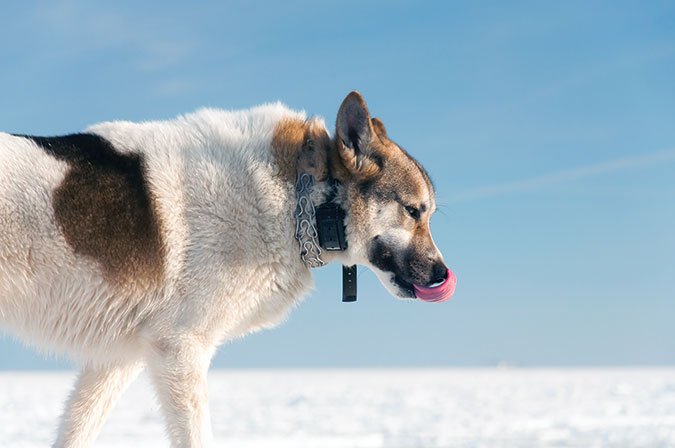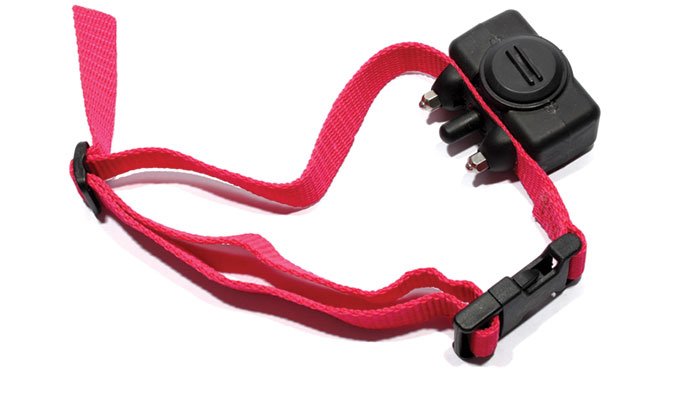Do you use an underground electric shock fence to contain your dog? Are you considering having one installed? I hope reading this will change your mind.
More and more neighborhoods prohibit or limit the useof fencing, and as this occurs, the use of these non-visible electric shock perimeters has drastically increased. Manufacturers and retailers claim that these products are humane, effective means by which to safely confine dogs without disrupting the aesthetics of neighborhoods. Companies that sell these products generally target families who:
- Live on larger pieces of land
- Don’t want to lose their “view”
- Are looking for a cheaper alternative to fencing,
- Live in neighborhoods that prohibit fences or require expensive, decorative styles

Modern dog behavior specialists generally agree that these products are neither safe nor humane for dogs or humans. Many dog training and behavior professionals have concluded that these products are the source of many fear-based behaviors, including aggression, and are only as effective as the pain and fear they inflict upon the dogs who live behind them.
How Do Electric Shock Collars Work?
A non-visible electric-shock perimeter consists of three components: a cable, a transmitter, and a pronged collar.
The cable is buried beneath the ground, surrounding the area in which the dog is to be confined, or from which he is prohibited to enter. Usually, the location of the buried cable is initially marked with a series of flags inserted into the ground in a line.
The transmitter, installed near the buried cable, broadcasts radio signals that travel the length of the cable.
The dog’s tightly fitted collar contains a small radio receiver, which receives signals from the transmitter when the dog (and receiver) get within a specified distance from the buried cable. The dog’s skin completes an electrical circuit, allowing the prongs, typically half an inch or more in length, to conduct electricity. When the dog steps near, over, or beyond the buried cable, he receives an electrical shock.
How Are Dogs Trained with Shock Collars?
Traditionally, a dog is allowed to wander into (or is actually encouraged to walk into) the boundary area – the “shock zone” – in order to receive an electric shock. The unit on the dog’s collar makes a beeping sound just before the dog enters the shock zone. This is repeated until the dog clearly indicates that he doesn’t want to enter the shock zone (and thus leave the yard), often by freezing, dropping to the ground, pacing and whining, etc. The dog may also yelp, panic, or try to bite.

The handler increases the intensity of the shock if the dog does not exhibit overt avoidance-type behaviors. Eventually, the dog associates the sound of the beep with the physical sensation of the shock. The beep is now a signal that warns the dog of the impending shock, and most dogs learn to stop their forward movement when they hear the beep.
Instead of shocking the dog, some handlers walk the dog on leash near the perimeter flags, jerking him away when the beep sounds. After several repetitions, the dog may avoid the flags because, in his mind, flags and beeps cause annoying or painful leash-jerks. If the handler excludes the beep during training, she negates its function: to provide a warning to the dog.
Some handlers may use food or play to encourage their dog to remain in the safe areas of the yard. However, without some sort of painful stimuli being paired with the flags or the shock, at some point the dog is bound to attempt to leave the yard and will be shocked.
Some owners are instructed to simply put the collar on their dog and let him into the yard, allowing him to enter the “shock zone” on his own. Families are falsely assured that this will prevent the development of problematic behaviors because they’ve made no attempt to warn the dog about the shock; it occurs “naturally.”
Once the owner thinks that the dog has been successfully trained to stay in the unfenced yard, the flags are gradually removed, one or two flags at a time, until none remain.
Problems Related to Shock Collars
Adverse Side Effects
The following are signs that a dog is experiencing harmful side effects of a non-visible electric-shock perimeter:
• Pacing back and forth along property lines
• Cowering or running from neighbors or passersby
• Conversely, chasing cars, bicycles, animals, passersby, etc.
• Regression in potty training
• Hesitating or refusing to venture far from the house
• Refusing to leave the house
• Refusing to leave the yard for walks
• Excessive barking and jumping toward people or other pets, especially as they enter or exit the property
• Lying in the middle of the driveway or under or behind vehicles when people try to enter or exit the property
• Refusing to enter or play in certain parts of the yard
• Developing a fear of getting into the car or leaving the property inside of a vehicle
Dangerous behaviors may appear quickly, or may not appear for a year or more following initial training to the system:
• Aggressing toward neighbors, passersby, vehicles, etc.
• Aggressing toward people leaving by foot (examples: children getting on the school bus; owner walking to the mail box)
• Nipping or biting children, especially when playing outside
• Attacking other pets or people who are close to the dog, especially in the presence of passersby
• Attacking someone or another animal upon exiting the yard, or a person or animal who enters the yard
Many (if not most) of my training colleagues have been consulted by owners of dogs who developed serious behavior problems (such as the ones that appear in the list above) not long after a shock-collar boundary was introduced to their habitat. In many cases, the dogs’ owners were mystified. How and why did this happen?
Dogs are motivated by what works for them. They gravitate toward safety and avoid danger. Non-visible shock perimeters take advantage of the dog’s survival instinct: what lies beyond the yard harms (shocks) them, so the dogs try to protect themselves.
Many of the problematic behaviors related to these products are caused by the initial training process. Others are a result of the constant threat of being shocked, similar to a dog who, after being swatted with a newspaper several times, may become frightened of newspapers in general; if his just owner picks up or touches one the dog stops whatever he’s doing because newspapers are dangerous.
Some dogs are willing to suffer the shock to investigate something outside of their yards. Some may not even notice the shock because they are so highly aroused. These dogs may also develop unsafe behaviors. Boredom may be the culprit for dogs in the first category, and over time they may become desensitized to the shock. This does not mean that the dog has forgotten about the shock – the threat is still there, but the shock has become irrelevant in some situations.
Dogs in the second category tend to be high-energy, highly motivated working breeds, although any breed of any size or age may break through a non-visible shock perimeter, especially if highly aroused. When stress-hormones levels spike, the dog essentially “turns off” to everything else, and his body does not perceive a signal from the brain when he is shocked.
More Arguments Against Shock Perimeters
Here are other drawbacks associated with these systems:
- Dogs often associate the shock with things that are present or nearby when he’s been shocked, like other animals, family members, or yard decorations, and can react badly to them as a result.
- Collars can short out when they get wet, increasing the risk of malfunction and injury.
- Collar malfunctions can lead to constant shocking or none at all.
- Dogs may get stuck in the shock zone, unable to move, causing intensified, long-lasting pain, increasing the likelihood of injury and a bite to anyone who may reach to pull them out. Electronic devices on the same frequency (such as garage-door openers) can trigger random shocks.
- Dogs may generalize the beep to similar sounds made by microwaves, car door locks, utility vehicles, etc. and develop a phobia to those sounds.
- Manufacturers instruct that collars be worn for no more than 10 to 12 hours at a time, but many product trainers advise that dogs wear them constantly, claiming this prevents the development of adverse effects.
- Dogs may need regular retraining.
- Dogs who leave the yard often don’t return, even if the collar is removed.
- Dogs can learn to run down the battery by waiting where the beep occurs until the beep stops so they can leave without getting shocked.
- The signal only goes to a certain height, and some dogs learn to jump higher and/or will walk out if snow piles up.
- Dogs may run from the yard in panic during storms, fireworks, when gunshots are heard, etc.
- An owner may be liable for any injuries or damages, including medical and veterinary bills, counseling and behavior modification, or property damage associated with events resulting from the dog leaving the yard.
- Homeowner Associations which prohibit fences and other outdoor confinement may be responsible for injuries, deaths or damages caused by a loose dog, and/or injury or death of a loose dog, particularly those which require dog owners to use these products.
- Many breeders, shelters, and rescues will not place dogs in homes where these products are used.
- Dogs in multi-dog families may feel the shock at different intensities.
- If the dog is put on the system during one of the critical fear periods of development, the adverse side effects may be more severe.
- Owners and veterinarians have reported moderate-to-severe bacterial infections, contact necrosis, and electrical burns from the use or misuse of these systems.
Deception in Electric Perimeter Advertising
Marketing professionals sell their clients’ products by invoking pleasant emotions about the product being presented to the consumer. To achieve this, they sometimes take liberties with facts by skewing them to achieve these ends, incorrectly redefining words like “fence” and “safe,” and taking advantage of individuals’ personal interpretations of the word “humane.”
For a better understanding of how marketing can lead well-meaning families astray, here are the actual definitions of some of the words being used to describe these products.
Fence: A barrier enclosing or bordering a field, yard, etc., usually made of posts and wire or wood, used to prevent entrance, to confine, or to mark a boundary; a means of protection.
Safe: Free from harm; not able or likely to be lost, taken away, or given away; not causing harm or injury, especially having a low incidence of adverse reactions and significant side effects when adequate instructions for use are given; having a low potential for harm under conditions of widespread availability.
Humane: Inflicting as little pain as possible, not cruel, acting in a manner that causes the least harm to people or animals.
Shock Collar Conclusions
Given the ample anecdotal and scientific evidence, it’s clear that electric-shock perimeters have detrimental effects that can cause moderate to severe behavioral and physiological problems in dogs, and also pose a threat to the communities in which they are used.
Frankly, if it’s not visible, it isn’t a fence. If something that is marketed as a protective product works by purposely inflicting pain and/or fear on the subject it’s supposed to protect, it’s neither safe nor humane.
What does this mean for dogs and their families? Simply put, a visible, physical barrier always trumps the absence of a physical barrier, especially when the product in question is so widely known to yield such an abundance of harmful side effects.
Lauri Bowen-Vaccare, owner of Believe In Dog, LLC, is a member of the Pet Professional Guild. Her specialties include reactivity, resource guarding, bringing outside dogs in, outside dogs, and transitioning to a new home.







My 9 month old, beautiful mini Australian Shepherd died on July 3rd. Results of the necropsy, the doctor believes the e collar malfunctioned which caused a heart arithmia. No obvious burn marks on his neck or throat. Can you suggest where I might have the collar evaluated?
Thank you
I have a 6 month old beagle. She has been trained with a hidden fence. I no longer even have to put the collar on her. She stays within the yard .I am very happy with the hidden fence and I think some of these remarks are just aimed to scare people.
This is an irresponsible article using fear inducing misinformation. When properly used, these systems safely and successfully train pets to remain inside the intended area. Perhaps you need to research the products a bit more prior to making such outlandish claims. If you need help with that, please reach out to me.
So how does this invisible fence prevent coyotes coming on your property and killing your puppies ? You don’t have to fence the entire 10 acres, just a small section of it. When you’re home you could try taking your puppies for a walk
meant for Dianne Perla
What is a person to do when there are 10 acres with a VERY busy highway yards from the house and coyote looking to kill small dogs? This “fence” has worked very well since I had it installed (after my dog was hit on the highway). I certainly do not advocate the administration of pain as a learning tool but I cannot be out with my puppies all day!
I agree. I have used mine for years and have never had a problem. This is an unfair article. My dogs have never exhibited any of the behaviors listed.
This is hogwash. We have had 5 dogs on an underground fence. They have not died on they highway(which is very busy). They are not on a chain. They do not test the fence. They may have been shocked 3 to 4 times in training. They are on the lowest wattage. They are able to run free on property. We have never encouraged them to leave the fence. That was explicit in training. And they are happy dogs. Not any more damaging then from spanking or punishing kids. Or a swat on the butt when they do something dangerous. Yes. I did spank my kids for good reason. So I will train my dogs to stay in yard and keep off the highway.
Where is the objective evidence for these claims? Tens of thousands of dogs are kept safe and out of harms way at the cost of a very brief exposure to discomfort. These exaggerated claims fail to keep the matter in perspective. There is unfortunately a chauvinistic mass movement at work that uses propaganda like this article in an attempt to control the choices that others may choose to make about the tools and methods used to train dogs and the means to keep them safe. They often claim that their assertions are based on science and evidence. However, when you examine their evidence with any diligence you find that more often than not the evidence is from the same people making the claims, and therefore biased and prejudiced and not objective. This movement wants to ban everything except that of which they approve. Before long they will want to ban leashes and dog crates because these might hurt the feelings of dogs.
I completely disagree with this article. This is a closed minded pro-animal writer.
I have placed terrier puppies in what I considered good homes only to find later the owners have installed these “fences.” They are not suitable for all breeds. A small hunting terrier will take a shock to try to get to prey. Recently I have boarded a two year old terrier I placed who has recently been a victim of one of these fences, while it’s owner underwent surgery. The dog spins in circles and is quite aggressive. I blame this awful product. It is a very sweet breed and this puppy had no aggression or aggressive traits prior!
where are the citations to scientific studies? i dont see any but to other blogs and for that reason i will trust your conclusion
I find it absolutely irresponsible of the author to state that there have been many studies done on this, yet does not show us even one scientific study that was done. Shame on you.
I’ve used an electric fence for 20 years. My dogs have more road protected space in which to play. I have not experienced “weird” dog behavior.
And these things are legal? You Americans need to take a long hard look at yourselves and the ease at which you hand out pain. If you aren’t chopping off ears and tails you are crating for hours and hours then stick instruments of torture round their neck when you deign to take them for a walk
This does not print well, at all. FYI. I have to print the article as landscape, rather than portrait.